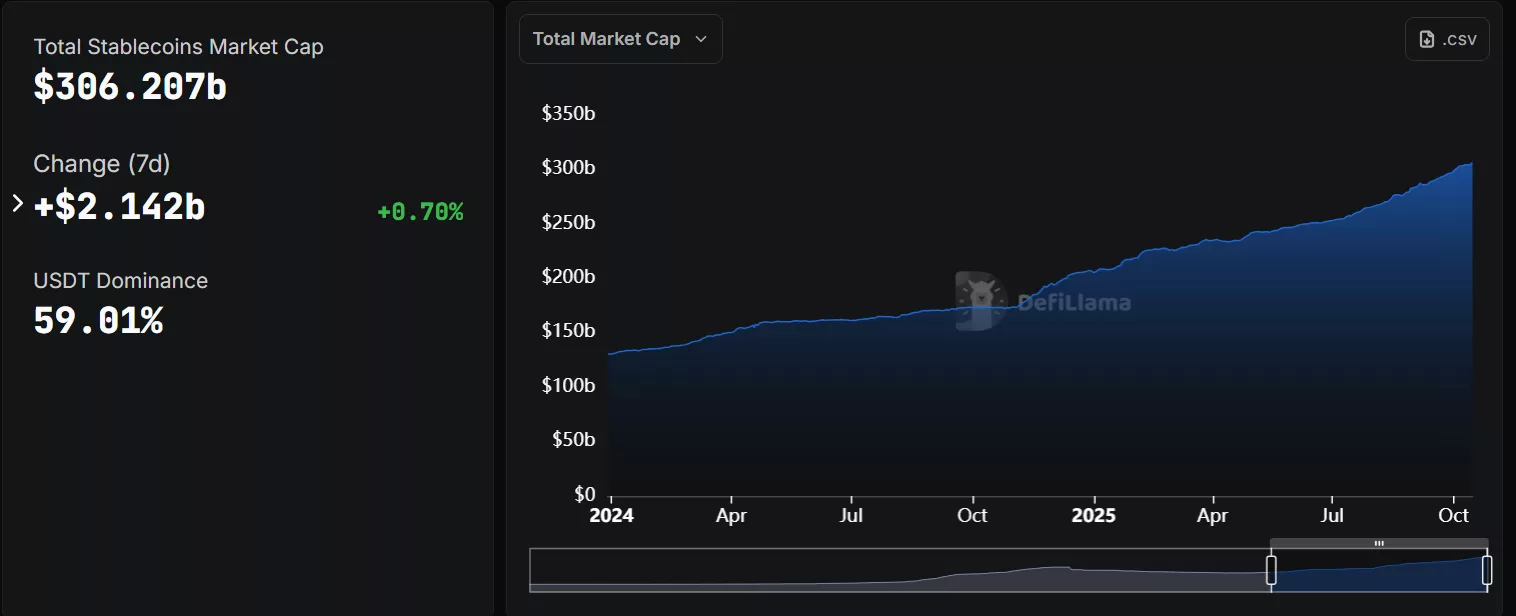Matrixport noted that stablecoin inflows have continued to dominate the market in spite of the crash, signaling that the crypto cycle is still going strong amidst volatility.
Summary
- Despite recent market crashes and increased short positions from whales, the stablecoin sector has remained resilient, with USDT and USDC collectively generating $74 billion in new inflows.
- Matrixport highlighted the rapid growth and maturity of the stablecoin market, now exceeding $300 billion in value, as evidence of the crypto industry’s diversification.
In a recent report, the on-chain analysis platform highlighted the growth of stablecoins and their ability to hold up despite crashes in the market. In fact, it may be the hedge that holds up crypto liquidity in spite of market volatility seen in other tokens.
On Oct. 14, the crypto market experienced a major crash that led to several major tokens like Bitcoin (BTC) and Ethereum (ETH) plummeting below established thresholds. Not only that, ahead of the Fed Chair speech, whales were seen powering through by increasing short positions on a number of altcoins as they anticipated a market crash.
However, despite these setbacks, the stablecoin market remained strong. According to the post, Tether’s stablecoin USDT (USDT) has shown increasing growth, rising to $180.6 billion in total market cap. Meanwhile, Circle’s USDC (USDC) managed to rack up $76.1 billion in value on-chain.

“Despite the recent crypto crash, stablecoin inflows remain one of the clearest signs that this is neither the end of crypto nor the end of this cycle,” noted Matrixport in its latest post.
Within just this year, Tether has minted about $42 billion worth of stablecoins. Meanwhile, Circle has minted another $32 billion. In total, the two stablecoin issuers have managed to generate $74 billion in fresh inflows that support the crypto market liquidity.
Matrixport’s outlook on stablecoins
Although Matrixport noted that the $74 billion inflows are still a long way from the $3 trillion prediction from Treasury Secretary Scott Bessent, the on-chain analysis firm believes that the phenomenon has proven that the digital asset landscape has diversified and matured over the years.
This is especially true in the case of stablecoins, which have grown in scale and global adoption. At press time, the total stablecoin market cap has reached over $300 billion, marking a first for the industry.
Within just five years, the stablecoin market cap grew from just $4 billion to more than $300 billion. In 2025 alone, the market received a $100 billion boost as investors flocked to adopt the new financial payment technology that could process cross-border settlements faster.
Despite JPMorgan and other entities predicting that stablecoins would serve to boost demand for the U.S dollar, as more overseas companies start making use of stablecoins pegged to the U.S. dollar, Matrixport believes that de-dollarization is also on the rise.
“The de-dollarization trend is also accelerating, driving demand for stablecoins as on-ramps into higher-yielding assets and as hedges against fiat-currency weakness,” wrote Matrixport in its recent analysis, adding that liquidity has now been flowing into the crypto market through “more sophisticated channels.”
Back in July 2025, just days after the U.S government passed the GENIUS Act, Executive Director of the President’s Council of Advisers on Digital Assets, Bo Hines, predicted that the crypto market would see a surge in value following the act’s legalization.
He stated that the digital asset industry would see a leap of value from its current $3 trillion to $4 trillion to about $15 trillion to $20 trillion in the near future, thanks to the stablecoin bill.